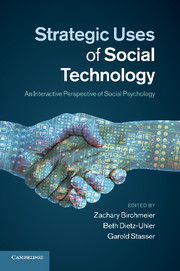Book contents
- Frontmatter
- Contents
- Figures
- Tables
- Notes on the contributors
- Acknowledgments
- 1 Introduction
- 2 A SIDE look at computer-mediated interaction
- 3 Trust, deception, and identity on the internet
- 4 An interactional approach to social influence in computer-mediated communication
- 5 Social interaction in cyberspace
- 6 Dynamics of leader emergence in online groups
- 7 Ostracism in cyberspace
- 8 Opinion-based groups
- 9 A juxtaposition of social influences
- 10 The virtual social world
- Index
- References
9 - A juxtaposition of social influences
Web 2.0 and the interaction of mass, interpersonal, and peer sources online
Published online by Cambridge University Press: 07 October 2011
- Frontmatter
- Contents
- Figures
- Tables
- Notes on the contributors
- Acknowledgments
- 1 Introduction
- 2 A SIDE look at computer-mediated interaction
- 3 Trust, deception, and identity on the internet
- 4 An interactional approach to social influence in computer-mediated communication
- 5 Social interaction in cyberspace
- 6 Dynamics of leader emergence in online groups
- 7 Ostracism in cyberspace
- 8 Opinion-based groups
- 9 A juxtaposition of social influences
- 10 The virtual social world
- Index
- References
Summary
Contemporary web-based communication technologies often present a juxtaposition of multiple sources. In January of 2009, for instance, CNN.com and Facebook.com partnered so that internet users could see and hear President Barack Obama's inauguration in one window, and read and write comments about it with myriad other viewers in another window. YouTube.com presents not only videos but also the comments that viewers have posted about the video. Facebook.com supports individuals’ self-descriptive information online, but also “wall postings” by a profile owner's friends, which may enhance, modify, or contradict the self-presentations individuals attempt to make. Sellers on eBay advertise goods online, and other buyers’ ratings of those sellers are a click away. Travel sites offer hotel listings alongside ratings and reviews by previous guests. And in addition to the overt comments and statements left online by people, the computational systems supporting these interactions often provide interesting statistical coefficients summarizing the evaluations or even the electronic footprints users leave behind: How many people rated a product evaluation as useful? How many times has a viral video been viewed, or a journal article been downloaded? How many friends does an individual have on Facebook? In all of these cases, there is a central message, and there are socially generated responses. How do these mutual sources of influence affect users?
New communication technologies are changing the manner of reception by which individuals acquire information from institutional, interpersonal, and peer information sources. Technology changes the temporal and contiguous presentations of these sources, and may in fact change the information processing and social influence dynamics among these sources; that is, the sequence with which sources are sampled or the simultaneity with which they appear may have potent effects on the information processing filters and biases. Such developments in communication technologies are raising new questions and resurrecting old questions about the interplay of interpersonal and mass communication. New technologies blur the boundaries between interpersonal and mass communication events and/or the roles that communicators take using new systems. Arguments have been made that the “convergence” of old and new media demands new and unified perspectives on traditionally segregated processes. “Media convergence” is a term that has been used to connote several phenomena that are brought about by advancements in telecommunication technology that may change some aspect of the communication process. Sometimes the term refers to the blending of previously individuated mass media: one can watch movies on one's computer, for example. We wish to discuss another kind of convergence: the potential for simultaneous communication via computers of both mass and interpersonal channels. Additionally, new and salient sources of information are present, and potentially influential, via contemporary online information systems: peer communication and computational summaries of social behavior. How these forms and sources of information coalesce, confirm, or contradict one another asks for conceptual and analytic frameworks to address them. New technologies invite research that will advance understanding of how individuals conceptualize communication and interpret messages, and how their attitudes are changed as a result of new mediated message forms and content.
- Type
- Chapter
- Information
- Strategic Uses of Social TechnologyAn Interactive Perspective of Social Psychology, pp. 172 - 194Publisher: Cambridge University PressPrint publication year: 2011
References
- 16
- Cited by



